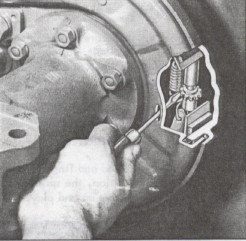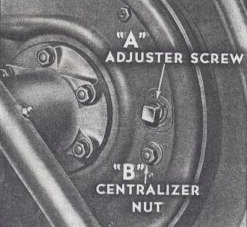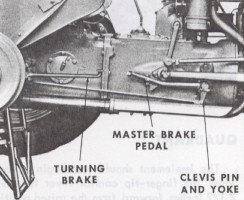BRAKE ADJUSTMENTS ON YOUR FERGUSON TRACTOR
Checking the operation of the brakes
The tractor brakes should be checked while the tractor is in motion to determine their effectiveness. The turning brakes should be effective with moderate pressure and there should be only a small amount of slack in the brake linkage. If the brakes are not satisfactory they should be “burned-in” and adjusted as follows:
Make sure all shafts and pins are lubricated and work freely. When the brakes are disengaged, check to see that the brake pedals are against their stops. Raise the tractor rear wheels with the Ferguson power jack (or block up rear axle on both sides).
Start the engine and operate the tractor in second gear (high range with hi-low transmission). Lock one wheel with its turning brake and apply easy turning brake pressure to the opposite revolving wheel until the brake drum becomes hot to the touch. Reverse the procedure and “burn-in” the opposite brake. Allow the brakes to cool before adjusting.
Adjusting the brake shoes: TO-20/30/35 & F-40
Remove the cover from the adjusting hole in the backing plate and, using a screwdriver or brake tool, turn the adjusting star wheel (see Figure 1) counter clockwise (when viewed from above until a drag is felt as the wheel is turned. Back off the star wheel until the wheel rotates freely and repeat the procedure on the opposite wheel.

Figure 1. Brake adjuster on TO-20/30/35/F-40 models.
Adjusting the brake shoes: TE/TEA-20 Series
Loosen the centralizer nut (see Figure 2) and expand shoes fully in the drum by turning the adjusting screws clockwise until wheel is locked. Tighten the centralizer nut and loosen the adjuster screw until the wheel turns freely
without drag. Repeat the procedure on the opposite wheel.

Figure 2. Brake adjuster on TE/TEA-20 series models
Adjusting the linkages for even stopping
For TO-35/F-40, lock the brake pedals together (for earlier models use the master brake) and test by driving the tractor on level ground and applying the brakes. If the linkages are correct, the tractor will come to a stop in a straight line. If not correct, the tractor will pull to the side with the shorter linkage. This is corrected by tightening the clevis yoke (see Figure 3) on the brake rod of the opposite side. Both brake linkages, however, should have a small amount of free play before the brakes are applied.

Figure 3. Brake linkage shown on TO/TE/TEA-20 series.
Adapted from Ferguson On-the-Farm Service Manuals (1953, 1956) and Ferguson Dealer Shop Manuals.
Revised 9/19/10